The Museum Collections
Introduction
I. History and Art Collection
1. Icons of the 14th – 19th centuries
icons of the 14th – 17th century
2. Jewelry art of the 14th – 20th century
jewelry art of the 14th – 17th century
jewelry art of the 18th – 19th century
the european silver 14th - 19th centuries
3. Small-size sculptures (works of metal, wood, bone)
XI – the beginning of the XX century
Small-size sculptures 11th – 17th century
Small-size sculptures 18th – early 20th century
enamel of Troitza masters 15-8th – early 20th century
5.Embroidery, lace, textiles of the 14th - early 20th century
icon and ornamental embroidery
gold and silver lace
6.Painting of the 18th – 21st centuries
painting of the 18th – 19th centuris
painting of the 20th – 21st centuris
II.Manuscripts and old printed books of the 14th – 17th century
IV.Lithography of the 18th – 19th century
V.Numismatics
VI.Medals of the 18th - early 20th century
VIII.Archeology collection
IX. Russian folk and applied and decorative art of the 17th – 21st c.
1. Artistic wood
folk carved and painted wood
wooden toys
house carving of Sergiev Posad
Khokhloma and Gorodets painting
2. Artistic textiles
embroidery and weaving
printed textiles and lace
Russian shawls
folk costumes
folk garments
printed cotton kerchiefs
|
Jewelry Art of the 18th – 19th centuries (page 3)
|
Precious and semi-precious stones were used in a various crosses and panagias. The special hall at the exposition houses precious articles of liturgical service connected with Father Superior of the Trinity-St. Sergius Lavra (1821 – 1867) Filaret Drozdov, Metropolitan of Moscow. Eclecticism was a synonym of the 19th century culture. Filaret’s long ministry coincided with the social interest in national roots. In church art “Russian style” prevailed.
The first stage of Russian style (1830 – 1860) was called Russian Byzantine or archeological style. The so-called Korsun cross is referred to the archeological trend. It belonged to Archimandrite Antony Medvedev, the vicegerent of the Trinity-St. Sergius Lavra. The crescent collar with the late 16th century cameo belongs to the same style. Historical romanticism called into existence such a phenomenon as reconstruction of ancient rarities
|

Pectoral cross. Mid-19th century |
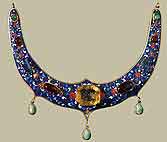
Crescent collar. 1869 |
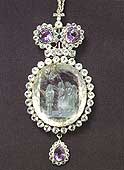
Panagia. Mid-19th century. Russia. Silver, rock crystal, amethysts. Donated by honorary citizen of Kansk G.F. Masherov in 1850 |
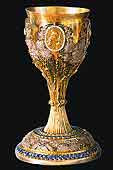
Chalice. St. Petersburg. 1854. |
In the late 1860s “the folklore” trend was considerably promoted by the peasant reform. The precious reliquaries, shaped like wooden churches, were quite characteristic works of the 19th century. Works in Russian style were also produced for memorable dates. Thus, in 1867, the citizens of Moscow presented a salt-cellar to Metropolitan Filaret to mark 50 years of his archbishop service.
Striving for national decorativeness was reflected with special emphasis in numerous enamel utensils. The ancient techniques of cell enamel, chamfer enamel, painted enamel, enamel on relief and filigree patterns were frequently used again. Thus, the chalice of the last three decades of the 19th century is a good example of enamel. The gold icon-lamp of 1892 was presented by the citizens of Sergiev Posad “for the tomb of St. Sergius” to mark 500 years of his commemoration. Its decoration imitated pierced wood work that was considered very stylish. Gradually the Russian trend was replaced by modern style. Soft overflowing colors splendidly corresponded to the plastic modern ornaments.
|

Reliquary. Moscow. 1888 |

Chalice. Last three decades of the 19th century |
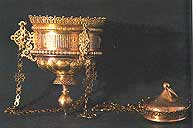
Icon-lamp. 1892. Moscow. P.A. Ovchinnikov firm. Donated to the Trinity-St. Sergius Monastery by the citizens of Sergiev Posad. |
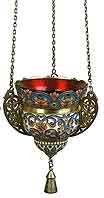
Icon-lamp. Moscow. 1899- 1908 |
The church objects of the 19th century are richly decorated with enamel and precious stones. At that time multicolored schemes were most significant elements of national art. The altar cross, made in Perm in 1891, is impressively decorated with numerous shining stones: violet amethysts, yellowish topazes, transparent rock crystal, red and green garnets. Among the 19th century precious works one should mark the pontifical panagia, donated by Moscow Metropolitan Filaret to the Trinity-St. Sergius Lavra. It is a superb work of jewelry art.
ÏThe folding icon with the image of St. Sergius of Radonezh was carved in bone and framed in silver by monk Iona (Ivan Iljin). In 1867, it was sent to the World Exhibition in Paris and returned with the honorary approval. The collection also includes silver vessels, tumblers in particular, made by the Trinity silversmiths for Ñouncil tabless. The tumbler, made in 1880, is decorated with beautiful engraving and chasing.
The verses, engraved on the tumbler, run: Entire Holy Russia trembles because of Mamai/ Prince himself hurries/ For the blessing of Sergius/ His brow shows trouble/Don’t you worry said the elder/ You will win. Believe it
|
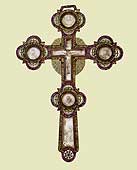
Altar cross. 1891. Perm. Donated by I.V. Popov and E.S. Popova. |
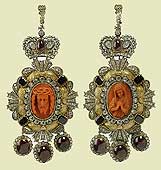
Panagia. Russia. 1845. Donated by Metropolitan Filaret (Drozdov). |
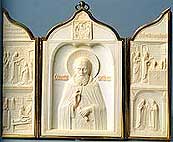
Folding icon. St. Sergius of Radonezh with scenes from his life. 1866. The Trinity-St. Sergius Lavra. Work of monk Iona (Ivan Iljin) |
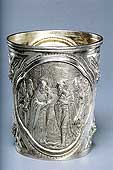
Tumbler. 1880. Workshops of the Trinity-St. Sergius Lavra |
The Sacristy presents personal belongings of Filaret (Drozdov), the Trinity-St. Sergius Lavra Father Superior, Metropolitan of Moscow and Kolomna buried in the Monastery and canonized in 1994. Two icons, painted in M.D. Shein workshops, are decorated with gilded silver mountings. The gold panagia is decorated with pearls, turquoise, almandines, emeralds and diamonds. Chasing, cutting and painted enamel on the chalice prove the craftsmen’s great skill.
|
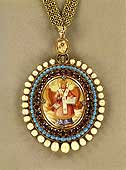
Panagia. Russia. 1830s. Belonged to Filaret (Drozdov) |
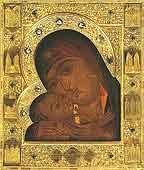
Icon in a mounting. The Virgin of Dnepr. Moscow. Workshop of M.D. Shein. 1867. Belonged to Filaret (Drozdov) |
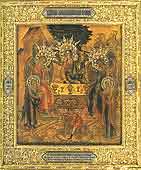
Icon in a mounting. The Trinity of Old Testament. Moscow. Workshop of M.D. Shein. 1867. Belonged to Filaret (Drozdov) |
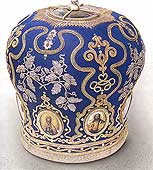
Mitre. Mid-19th century. Belonged to Filaret (Drozdov) |
|


